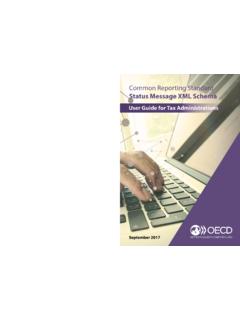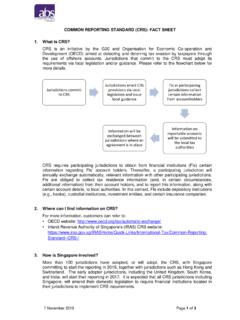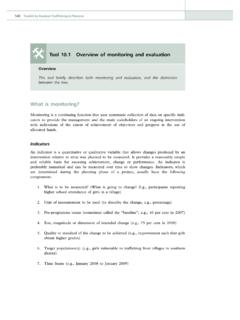Transcription of CRS Common Reporting Standard - OECD.org - …
1 1 CRS Common Reporting Standard Technical manual for the presentation of the CRS report 2 Table of Contents 1. Introduction .. 4 2. General information on the Reporting of information .. 5 a. Type of 6 b. Message format .. 6 c. Reporting via sFTP .. 6 d. Test period .. 9 3. Technical characteristics of the XML file .. 9 a. File name .. 9 b. Permitted and prohibited characters .. 10 c. Numeric values .. 11 d. Specification of the SchemaLocation in the XML file .. 11 4. Functional specification of the messages .. 13 a. Reporting message .. 13 b. Response message.
2 14 5. Characteristics of the fields of the Reporting message .. 16 a. Specification of the PresentationHeader structure .. 16 i. Characteristics of the PresentationType field .. 17 ii. Characteristics of the DataQuality field .. 17 b. DocSpec specification .. 18 c. Specification of the ReportingFI structure .. 19 d. Specification of the AccountReport structure .. 19 e. General considerations .. 21 6. Adding new records and correcting and deleting records .. 22 a. Nil return .. 22 b. New report .. 23 c. Add accounts to a ReportingFI.. 23 d. Correct or delete accounts.
3 24 e. Correct a ReportingFI .. 24 f. Delete a ReportingFI .. 25 g. General considerations .. 25 7. Examples of messages .. 25 a. Nil return (NilReport) .. 25 b. New report .. 26 3 c. Add accounts to a ReportingFI .. 28 d. Correction and deletion of accounts associated with a ReportingFI .. 30 e. Correction of a ReportingFI .. 32 f. Deletion of a ReportingFI .. 33 8. Specific cases based on the account holder to be reported .. 34 a. Reportable account holder .. 34 b. Passive NFE .. 37 Annexe I: Schema diagrams .. 45 a. Schema diagram of the Reporting file .. 45 b. Schema diagram of the response file.
4 50 Annexe II: List of error codes .. 51 4 1. Introduction International exchange of tax information falls within the scope of administrative cooperation. It has its legal basis in international conventions, which can be bilateral or multilateral, depending on the number of signatory states. The conventions can be either specifically in relation to mutual assistance ( , information exchange agreements) or part of an international double taxation convention. The competent authority performs the information exchange function and is centralised in the Finance Ministry, so as to ensure the necessary cooperation and consistency in relation to the information exchange policy.
5 There are three types of information exchange on request, automatic and spontaneous which often are complementary. These three forms of exchange are provided for within the framework of the Multilateral Convention on Mutual Administrative Assistance in Tax Matters (the Multilateral Convention ) developed by the Council of Europe and the Organisation for Economic Co-operation and Development (OECD). The Global Forum on Transparency and Exchange of Information for Tax Purposes (the Global Forum ) is an OECD body that plays a key role in setting the standards to be followed in the preparation and application of international rules on the exchange of information for tax purposes between states.
6 It prepares, interprets and updates these standards and ensures their implementation in all the states through a global monitoring and peer review process. So far, Andorra has been the subject of two peer reviews under the Global Forum s ordinary programme. The first review (phase 1) carried out by the Global Forum examined the conditions and the legal and regulatory framework for mutual administrative assistance in relation to the exchange of information on request. The second review (phase 2) analysed the way in which information exchange in tax matters was put into practice.
7 The peer reviews are based on Terms of Reference relating to a list of items. Andorran Law 19/2016 of 30 November on the automatic exchange of information in tax matters (the AEOI Act ) implements in Andorra the OECD s Common Standard on Reporting and due diligence for financial account information, with the aim of improving international tax compliance through reciprocal automatic exchange of information subject to confidentiality and other safeguards, including provisions that limit the use of the information exchanged and applying data protection laws and practices in the processing of personal data.
8 The AEOI Act was passed by the Andorran parliament in its session on 30 November 2016 and was published in Issue 77 of the Official Gazette of Andorra (Butllet Oficial del Principat d Andorra), dated 22 December 2016. The Act came into force on 1 January 2017. The AEOI Act contains ten articles, one transitional provision, one repealing provision, two final provisions, and two annexes containing the OECD Standard for Automatic Exchange of Financial Account Information ( Common Reporting Standard ) and the complementary standards on Reporting and due diligence for financial account information.
9 The act regulates the automatic exchange of financial account information between Andorra and other states on the basis of applicable international agreements and conventions. The first such convention is the Agreement between the European Union and Andorra on the automatic exchange of financial account information in order to improve international tax compliance. This 5 agreement provides for automatic exchange of information between European Union Member States and Andorra, applying the OECD s Common Reporting Standard . The AEOI Act also regulates the automatic exchange of information on the basis of other international conventions or agreements, provided those other conventions or agreements apply the OECD s Common Standard on Reporting and due diligence for financial account information.
10 Thus, the act provides that the multilateral instrument for automatic exchange of information with states participating in the Multilateral Convention will be the Multilateral Competent Authority Agreement (MCAA), which is based on article 6 of the Multilateral Convention. The MCAA implements the Standard for automatic exchange of tax information. On 3 December 2015 Andorra signed the MCAA, becoming the 75th jurisdiction to do so. In addition, outside the multilateral MCAA, the Finance Ministry may, subject to approval by the Andorran parliament, enter into bilateral agreements with other states that are parties to the Multilateral Convention.















